Menu
Download the accompanying materials to this lesson plan - sign up here
Resources and materials for ESL Kids teachers
This lesson covers the main rooms of a house as well as vocab for some common household objects.
See our "Warm Up & Wrap Up" page.
1. Teach rooms vocab
Before class, cut out 6 pictures of household objects from a magazine/catalog: one for each of the rooms of a house, for example:
bed (for the bedroom), refrigerator (for the kitchen), shower (for the bathroom), TV (for the living room), dining table (for the dining room), flowers (for the garden).
On the board draw a picture of a house, similar to below. Make sure you draw it as big as possible to fill the board.
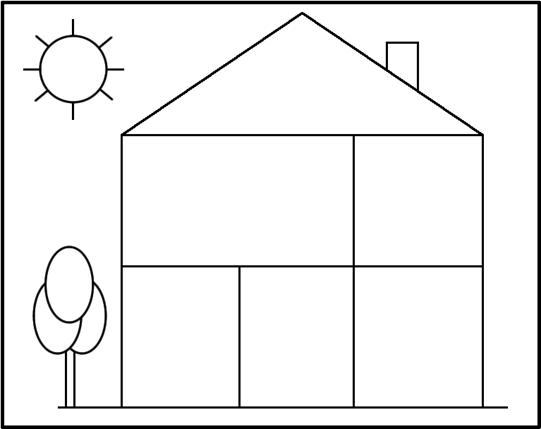
Elicit the words house, tree and sun. You can also teach/elicit "roof" and "chimney" as extra vocab.
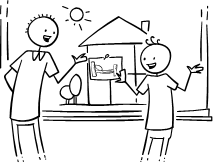 Next, hold up the cut out "bed" magazine picture and elicit/teach the word. Ask one student to come up to the board stick the picture in one of the rooms (make sure it is the large, upstairs room). Do the same with the other 5 pictures, each time eliciting the word and getting a student to stick on your house so that each room has a picture in it (and one outside in the garden).
Next, hold up the cut out "bed" magazine picture and elicit/teach the word. Ask one student to come up to the board stick the picture in one of the rooms (make sure it is the large, upstairs room). Do the same with the other 5 pictures, each time eliciting the word and getting a student to stick on your house so that each room has a picture in it (and one outside in the garden).
Now, elicit/teach the words for rooms of the house and garden: point at the bedroom and ask "What room is this?". If no one knows, say, "Well, it has a bed and it is a room, so it's a ..." and try and elicit "bedroom". Then write the word in the room and chorus 3 times.
Do a similar thing with the other places, e.g.
- bathroom: a room with a bath
- living room: a room where we live
- dining room: a room where we eat dinner (dinner room ... dining room)
- kitchen/garden: not compound words so can't teach this way - just teach and chorus.
2. Play the "Rooms of a house Quiz"
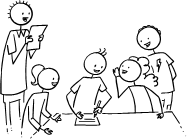 Put your students into groups (of 2-6 students per group, depending on how many students are in your class). Get each group to elect a team captain and then give each captain a piece of paper and pencil. Tell the captains to write the numbers 1 to 12 down the left-side of the paper. Each captain is going to write the 12 answers to the quiz questions on this sheet, but the rest of the group will help give him/her the answers.
Put your students into groups (of 2-6 students per group, depending on how many students are in your class). Get each group to elect a team captain and then give each captain a piece of paper and pencil. Tell the captains to write the numbers 1 to 12 down the left-side of the paper. Each captain is going to write the 12 answers to the quiz questions on this sheet, but the rest of the group will help give him/her the answers.
The teacher reads out the following questions as the groups write the answers on their sheets:
1. Where in the house do you brush your teeth? (bathroom)
2. Where in the house do you cook food? (kitchen)
3. Where in the house do you sleep at night? (bedroom)
4. Where in the house do you eat dinner? (dining room)
5. Where in the house do you sit with your family and watch TV? (living room)
6. Where do you see grass? (garden)
7. Where are your books, toys and games (bedroom)
8. Where are the dishes washed? (kitchen)
9. Where can you sunbathe? (garden)
10. Where does your family relax together? (living room)
11. Where can you get wet inside your house? (bathroom)
12. Where is the largest table? (dining room)
Finally, go through the answers with the class by pointing to the correct room on your board picture and helping out with any vocab that students don't understand. The winning group gets a round of applause from everyone.
3. Do "Rooms of a house Posters"
Put your students into 6 groups (for smaller classes, 3 groups is fine). Give each group the following:
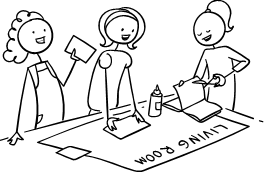 Assign each group a room of a house (or garden) and get the groups to write the room name at the top of their construction paper. So, for example, one group will make a "bedroom" poster, another a "living room poster", etc. If your class is small and you only have 3 groups, each group will have two pieces of construction paper (therefore they will do two room posters).
Assign each group a room of a house (or garden) and get the groups to write the room name at the top of their construction paper. So, for example, one group will make a "bedroom" poster, another a "living room poster", etc. If your class is small and you only have 3 groups, each group will have two pieces of construction paper (therefore they will do two room posters).
Tell everyone to look through their magazines/catalogs and cut out pictures to stick on their poster for their room. Demonstrate this with one room before you start to make sure everyone understands (e.g. in living room: a sofa, a TV, rug, coffee table, etc.).
Give students 5 minutes for this.
 When each group has finished, tell everyone that they have to write the words for the things they have stuck on their posters. Having picture dictionaries or even use of a computer is ideal for students to find the words. Another alternative is a catalog in English. If you don't have any of these resources, you can help students with the words they don't know. By the end, all of the pictures should be labeled correctly.
When each group has finished, tell everyone that they have to write the words for the things they have stuck on their posters. Having picture dictionaries or even use of a computer is ideal for students to find the words. Another alternative is a catalog in English. If you don't have any of these resources, you can help students with the words they don't know. By the end, all of the pictures should be labeled correctly.
When all of the posters are complete, get each group to stick theirs to the walls of the classroom - try and get them evenly spaced around the room.

4. Play "Touch the picture"
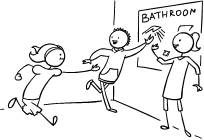 Get everyone to sit in the middle of the classroom. First, the teacher goes to each poster and choruses each picture 2 or 3 times (e.g. "bed, bed, bed"). Do this quite quickly to avoid students getting bored. Then, tell everyone that you are going to say an object and everyone has to race to touch it on the poster. The first person to touch it is the winner. Shout out a word (e.g. "shower!") and everyone rushes to touch that picture. Then continue shouting out other words, as students race around the room touching objects on the posters. This should be fast paced and fun.
Get everyone to sit in the middle of the classroom. First, the teacher goes to each poster and choruses each picture 2 or 3 times (e.g. "bed, bed, bed"). Do this quite quickly to avoid students getting bored. Then, tell everyone that you are going to say an object and everyone has to race to touch it on the poster. The first person to touch it is the winner. Shout out a word (e.g. "shower!") and everyone rushes to touch that picture. Then continue shouting out other words, as students race around the room touching objects on the posters. This should be fast paced and fun.
5. Play "Touch the picture" in pairs
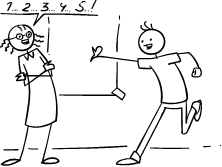 Now, pair up students. Student A will say an object from any poster and Student B has to find and touch it. Sounds easy? Well, give a time limit for the students to find and touch the picture (e.g. 5 seconds - depending on the levels of your students). For example:
Now, pair up students. Student A will say an object from any poster and Student B has to find and touch it. Sounds easy? Well, give a time limit for the students to find and touch the picture (e.g. 5 seconds - depending on the levels of your students). For example:
Student A: Find a lamp! 1 ... 2 ... 3 ... 4 ... 5 ... Time's up!
Student B: (runs around searching for a lamp picture to touch)
6. Do the "Objects in my house" worksheet
Give out the worksheets. First, get students to write the words for each room on their worksheets. Then get the students to use the posters around the room to write words and draw pictures of the objects they have in their home.
 NOTE: If students don't have certain rooms in their homes (e.g. dining room, garden) have them put in objects they have in other rooms that could go in those rooms.
NOTE: If students don't have certain rooms in their homes (e.g. dining room, garden) have them put in objects they have in other rooms that could go in those rooms.
When everyone has finished, put students into pairs. Teach the phase:
Do you have a/an (sofa)?
or
Have you got a/an (sofa)? (British English)
Then have pairs ask each other about what they have and don't have in their homes using their worksheets as a guide.
7. Read classroom reader "Mr. Stretch’s House"
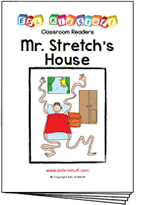 Let's end with a fun story that practices the vocabulary in today's lesson. Before class, download and print off the reader "Mr. Stretch’s House". As you go through each page, point to the pictures and elicit the rooms, as well as other vocab for the objects in the rooms, for example:
Let's end with a fun story that practices the vocabulary in today's lesson. Before class, download and print off the reader "Mr. Stretch’s House". As you go through each page, point to the pictures and elicit the rooms, as well as other vocab for the objects in the rooms, for example:
Teacher: (pointing at the picture on page 4) What room is this?
Students: The kitchen!
Teacher: Yes, that's right! What is Mr. Stretch getting?
Students: A banana!
Teacher: Yes, good job! He's stretching his arm all the way into the kitchen to get a banana! And where is he getting the banana from (pointing at the refrigerator)?
Students: A refrigerator!
Teacher: Yes, that's right! (Reading) "He is getting a banana from the fridge!". Do you have a refrigerator in your kitchen, Kate?
Kate: Yes, I do!
Teacher: And do you have bananas in your refrigerator?
Kate: Um, no.
Teacher: Kate doesn't have bananas in her refrigerator. Does any here have bananas in their refrigerator?
David: Yes, I do!
Teacher: Ah, David does! What other food is in your refrigerator?
David: Um. Ham and eggs and milk.
Teacher: Very good, David! Ok, everyone, what else is in Mr. Stretch's kitchen?
Students: A cooker!
etc.
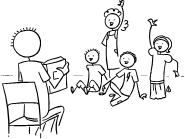 Get the students really involved in the story by asking lots of questions about the what objects they have in their homes.
Get the students really involved in the story by asking lots of questions about the what objects they have in their homes.
After reading the story, give out a reader worksheet to each student and read through the story one more time (without stopping for questions, etc.) as students match the objects in the story to the different rooms. Then go through the answers as a class.
---
Alternatively, watch our video version of the reader (Internet connection required):
1. Assign Homework: "Home Plan" worksheet (be sure to model this first by drawing a plan of your home).
2. Wrap up the lesson with some ideas from our "Warm Up & Wrap Up" page.
 Found a mistake?
Found a mistake?
Please let us know
Full access to all resources on ESL KidStuff including lesson plans, flashcards, worksheets, craft sheets,
song downloads, classroom readers, flashcards app and songs app.